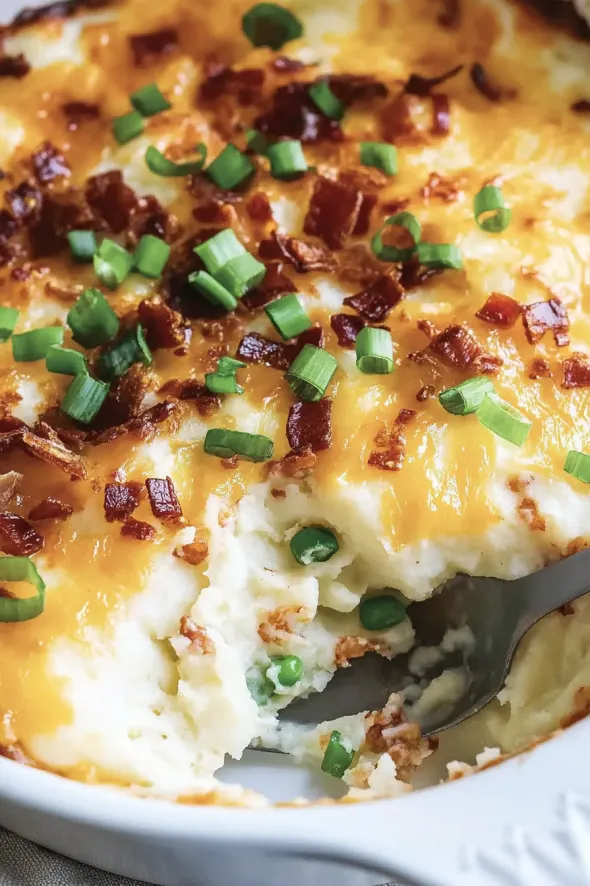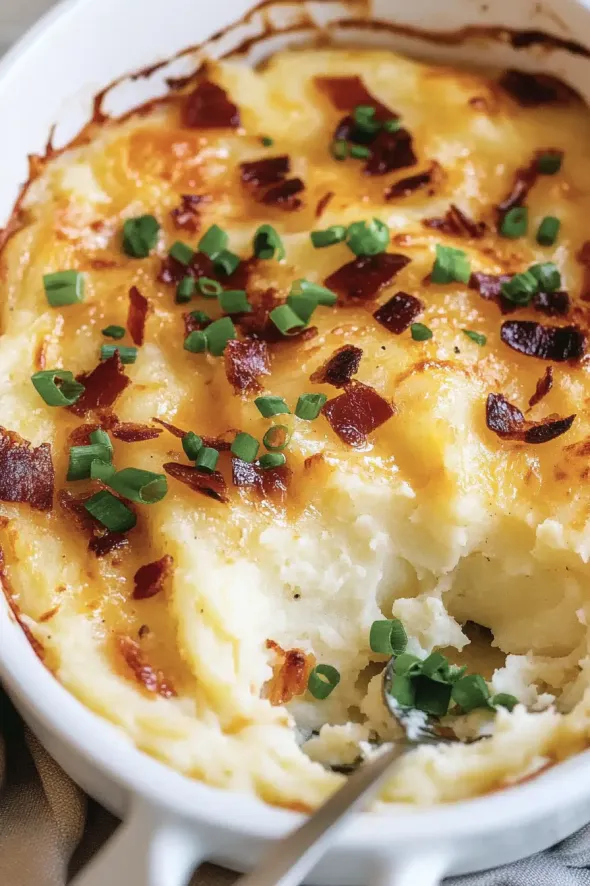 Pin it
Pin it
Loaded mashed potato casserole elevates the humble spud into a celebration-worthy side dish that combines creamy potato goodness with indulgent toppings. This crowd-pleasing creation transforms traditional mashed potatoes with the addition of melted cheese, crispy bacon, and fresh herbs. The magic happens when everything bakes together into a bubbling, golden masterpiece that pairs perfectly with any main course. Easy to prepare ahead and guaranteed to disappear quickly, this casserole bridges the gap between everyday comfort food and special occasion indulgence without requiring complicated techniques or exotic ingredients.
I discovered this recipe when hosting my first Thanksgiving as a newlywed. Nervous about timing multiple dishes to finish simultaneously, I searched for make-ahead options that wouldn't sacrifice quality. This casserole became an instant tradition, requested at every family gathering since. My mother-in-law, who rarely asks for recipes, cornered me in the kitchen after dinner for detailed instructions, which I consider the ultimate endorsement for any dish.
Key Ingredients Explained
- Russet potatoes (5 pounds): Creates the perfect fluffy yet substantial base. Their high starch content yields the creamiest mashed potatoes compared to waxier varieties.
- Butter (½ cup): Adds richness that transforms simple potatoes into something special. European-style butter with higher butterfat content creates exceptional flavor.
- Sour cream (1 cup): Introduces tangy richness while keeping potatoes moist even after baking. Full-fat varieties provide the best texture and prevent watery results.
- Milk (¾ cup): Creates the perfect consistency while adding creaminess. Whole milk works best, though half-and-half can be substituted for extra richness.
- Bacon (8 ounces): Provides savory crunch that contrasts beautifully with the creamy potatoes. Thick-cut bacon maintains better texture when baked.
- Shredded cheese (2 cups): Forms the gooey, golden topping that makes this dish irresistible. Freshly shredded cheese melts more smoothly than pre-packaged varieties.
- Chives or green onions (¼ cup): Adds fresh, bright flavor and visual appeal. Fresh herbs make a significant difference compared to dried alternatives.
- Salt and pepper: Enhances all other flavors in the dish. Kosher salt and freshly ground black pepper provide the best flavor profile.
Perfect Preparation
- Potato preparation matters:
- Begin by peeling and cutting potatoes into uniform 1-inch chunks to ensure even cooking. Place in a large pot with cold water and 1 tablespoon salt, bringing to a boil before reducing to a simmer. Cook until potatoes are fork tender but not falling apart, approximately 15-20 minutes. Drain thoroughly in a colander, then return to the hot pot for 1-2 minutes, shaking occasionally to remove excess moisture and create fluffier mashed potatoes.
- Create flavorful base:
- While potatoes cook, prepare the flavor infusion. Warm milk and butter together in a small saucepan until butter melts completely, but avoid boiling. This warm mixture incorporates more easily into hot potatoes than cold ingredients. Once potatoes are drained and dried, mash them while still hot until most lumps disappear. Some texture is desirable for this rustic dish.
- Add richness properly:
- Pour warm milk mixture into potatoes gradually while continuing to mash, allowing liquid to incorporate before adding more. Fold in room temperature sour cream until just combined, maintaining fluffiness by avoiding overmixing. Season generously with salt and pepper, remembering that potatoes absorb significant seasoning. Taste and adjust before spreading into baking dish.
- Prepare indulgent toppings:
- While potatoes are cooking, prepare bacon properly. Arrange bacon strips on a parchment-lined baking sheet and cook at 400°F until crispy, approximately 15-20 minutes. This method cooks bacon evenly without curling and makes cleanup simple. Drain on paper towels before chopping into small pieces. Grate cheese directly from block for optimal melting properties.
- Layer strategically:
- Spread seasoned potato mixture into a greased 9x13 inch baking dish, creating an even layer with gentle swirls for texture. Sprinkle prepared bacon evenly across the surface, followed by a generous layer of shredded cheese that completely covers the potatoes. Cover with aluminum foil, crimping edges to seal completely.
- Bake to perfection:
- Place covered dish in preheated 350°F oven for 25 minutes until thoroughly heated. Remove foil and continue baking for an additional 10 minutes until cheese melts completely and edges begin to turn golden brown. For extra color, broil for 1-2 minutes while watching carefully to prevent burning. Allow casserole to rest 5-10 minutes before garnishing with fresh chives.
 Pin it
Pin it
My family discovered the perfect hack for this recipe when preparing for a large gathering. We initially mashed potatoes the day before, refrigerated them overnight, then brought them to room temperature before topping and baking. Surprisingly, this actually improved the flavor complexity as the ingredients had time to meld. Now we intentionally make this casserole a day ahead even when time isn't an issue. Adding a thin layer of extra cheese just before baking creates a perfect seal that keeps potatoes moist during storage.
Troubleshooting Guide
Texture problems happen most frequently with mashed potato dishes. If your potatoes seem gluey or gummy, you've likely overworked them, breaking down too much starch. Next time, use a gentler touch when mashing and stop once most lumps are gone. Some texture is desirable for this rustic dish. For watery potatoes, ensure you've thoroughly drained them and returned them to the hot pot to evaporate excess moisture before mashing.
Temperature management prevents common issues. Always add warm milk and butter to hot potatoes for smooth incorporation. Cold ingredients added to hot potatoes can cause them to become dense and sticky. If preparing ahead, allow refrigerated potatoes to come to room temperature before baking to ensure even cooking. Covering with foil during initial baking prevents edges from drying out while the center warms.
Cheese selection impacts both flavor and texture. Pre-shredded cheese contains anti-caking agents that prevent smooth melting and can create a grainy texture. Invest the extra few minutes to grate cheese from a block for superior texture and flavor. For best results, combine a melting cheese like mozzarella with a more flavorful variety like sharp cheddar or smoked gouda to achieve both optimal texture and taste complexity.
Serving Solutions
Transform everyday dinners by serving this casserole alongside simple protein options like roasted chicken, grilled steak, or baked fish. The richness of the potatoes complements leaner meats beautifully, creating a satisfying meal without excessive preparation. Add a simple green vegetable like steamed broccoli or a crisp salad for a complete, balanced dinner that feels special without significant effort.
Elevate holiday gatherings by presenting this casserole in an attractive baking dish garnished with additional toppings. Create a "topping bar" with extra bacon, various cheeses, chopped herbs, and roasted garlic so guests can customize their portion. This interactive serving approach becomes a conversation starter while allowing those with dietary preferences to adapt their serving accordingly.
Customize presentation for different occasions by adjusting the serving vessel. For elegant dinners, transfer portions to individual ramekins topped with an extra sprinkle of cheese and broil briefly before serving. For casual gatherings, serve directly from the baking dish family-style. Either approach showcases the bubbling cheese topping and colorful garnishes that make this dish visually appealing.
 Pin it
Pin it
Creative Variations
Regional flavor inspirations create entirely new experiences. Southwestern style combines pepper jack cheese with green chiles and finishes with avocado and cilantro. Mediterranean influence incorporates feta cheese, sun-dried tomatoes, and fresh oregano with a drizzle of olive oil. New England variation features white cheddar with caramelized onions and a sprinkle of fresh thyme.
Dietary adaptations maintain flavor integrity while meeting special needs. Create a lighter version using Yukon Gold potatoes with their skins, reduced-fat sour cream, and part-skim cheese with extra herbs for flavor. Vegetarian options replace bacon with roasted mushrooms or sun-dried tomatoes for umami richness. For dairy sensitivities, substitute chicken broth and olive oil for some of the milk and butter.
Main dish transformations turn this side into a complete meal. Add shredded rotisserie chicken and steamed broccoli directly to the potato mixture before baking for a one-dish dinner. Create twice-baked potato casserole by mixing in caramelized onions and roasted garlic, then topping with breadcrumbs mixed with parmesan for extra crunch. For brunch, reduce milk slightly and add beaten eggs to the potato mixture, creating a savory breakfast casserole.
Storage Strategies
Prepare ahead successfully by completing all steps except final baking. Cover prepared casserole tightly with aluminum foil and refrigerate for up to two days. When ready to serve, allow casserole to sit at room temperature for 30 minutes before baking. Add an additional 10-15 minutes to the covered baking time to ensure the center heats thoroughly.
Store leftovers properly by covering cooled casserole with plastic wrap or transferring to airtight containers. Refrigerate for up to 4 days. The flavor often improves after a day as ingredients meld together. Reheat individual portions in the microwave at 70% power for more even warming, or reheat larger portions covered in a 325°F oven until heated through.
Freeze successfully by preparing through assembly but not baking. Cover tightly with plastic wrap followed by aluminum foil and freeze for up to one month. Thaw overnight in refrigerator before bringing to room temperature and baking as directed, adding 15-20 minutes to covered baking time. Alternatively, freeze individual portions in small containers for quick meal solutions.
 Pin it
Pin it
This loaded mashed potato casserole represents the perfect balance between comfort food simplicity and special occasion indulgence. Through years of making this dish for family gatherings, I've learned that it's the ideal vehicle for bringing people together around the table. The familiar, welcoming flavors appeal to everyone from my picky five-year-old nephew to my culinary-enthusiast uncle. While the recipe itself is straightforward, the result feels special enough for celebration meals while remaining approachable for everyday dinners. I particularly love how this dish allows for personal expression through various cheese and topping combinations while maintaining its soul-satisfying essence that makes everyone feel instantly at home.
Frequently Asked Questions
- → Can I make this casserole ahead of time?
- Yes! You can prepare the entire casserole up to 24 hours ahead, cover and refrigerate. When ready to bake, add about 10-15 extra minutes to the covered baking time since you're starting with cold potatoes.
- → What kind of potatoes work best for this recipe?
- Russet potatoes are ideal because they're starchy and make fluffy mashed potatoes. Yukon Golds also work well for a creamier, buttery flavor.
- → Can I substitute the cheese for a different variety?
- Absolutely! Cheddar, Monterey Jack, or Gruyere all work great. You can also use a mixture of cheeses for more complex flavor.
- → How can I make these potatoes extra smooth?
- For extra smooth potatoes, use a potato ricer instead of a masher. Also, make sure your butter and milk mixture is warm when you add it to the potatoes.
- → Can I freeze this casserole?
- Yes, though the texture may change slightly. Freeze before baking, then thaw overnight in the refrigerator before baking as directed, adding extra time as needed.
